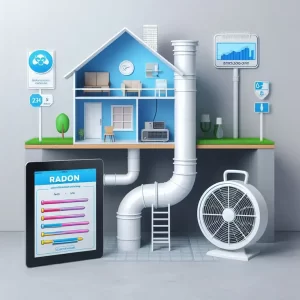Radon Testing | Mitigation
Radon testing and mitigation are essential for safeguarding indoor air quality and preventing lung cancer, the second leading cause linked to radon exposure. Testing involves using short-term or long-term kits to measure radon levels, with mitigation recommended if levels exceed 4.0 pCi/L. Effective mitigation often includes active soil depressurization and sealing cracks, supplemented by enhanced ventilation. Costs range from $800-$2,000, but professional installation guarantees compliance and long-term performance. Regular monitoring post-mitigation is necessary to maintain safety. For detailed steps and professional advice on effective mitigation, insight into specific procedures and benefits is available for further exploration.
Radon Overview and Health Risks
Radon is an invisible, odorless gas that forms naturally from the radioactive decay of uranium in rock, soil, and water, posing significant  health risks with prolonged exposure. It seeps into buildings through cracks and openings in foundations, making indoor spaces prime radon sources. Once inside, radon can accumulate to dangerous levels. Prolonged exposure to high radon levels is the second leading cause of lung cancer in the United States, responsible for approximately 21,000 deaths annually.
health risks with prolonged exposure. It seeps into buildings through cracks and openings in foundations, making indoor spaces prime radon sources. Once inside, radon can accumulate to dangerous levels. Prolonged exposure to high radon levels is the second leading cause of lung cancer in the United States, responsible for approximately 21,000 deaths annually.
Symptoms of lung cancer due to radon exposure often remain undetected until the disease has advanced. These symptoms may include persistent coughing, shortness of breath, chest pain, and frequent respiratory infections. As a result, awareness and regular radon measurement are vital.
Health guidelines emphasize maintaining indoor radon levels below 4.0 picocuries per liter (pCi/L). The Environmental Protection Agency (EPA) recommends corrective actions if measurements exceed this threshold. Understanding the health risks associated with radon is essential for homeowners and property managers. By recognizing potential radon sources and adhering to established health guidelines, individuals can take proactive steps to mitigate exposure and protect their health.
Testing for Radon
Determining the radon levels in your home involves using specialized testing methods to guarantee a safe living environment. Radon detection methods include both short-term and long-term test kits. Short-term tests, lasting between 2 to 90 days, provide a quick snapshot of radon levels, while long-term tests, over 90 days, offer a more accurate average. Professional radon testing services are also available, making certain precise results.
Understanding radon measurement units is vital. Radon levels are measured in picocuries per liter (pCi/L), and the EPA recommends action if levels reach or exceed 4.0 pCi/L. Regular testing is fundamental for health risk awareness, especially after renovations or changes in living conditions. Following testing frequency guidelines makes certain continued safety and ideal indoor air quality.
Homeowners should be proactive in testing for radon to mitigate potential health risks. Testing kits are readily available online or in home improvement stores, and instructions are typically straightforward. Making certain accurate radon detection methods and adhering to recommended testing intervals can greatly reduce the risk of long-term exposure, safeguarding the health of all occupants.
Radon Mitigation Techniques
Effective radon mitigation techniques are vital for reducing indoor radon concentrations and guaranteeing safe air quality in homes. Addressing radon exposure begins with understanding the most efficient methods to mitigate it. Active soil depressurization is the most common and effective technique. This involves installing a vent pipe system and fan, which pulls radon from beneath the house and expels it outside, markedly lowering indoor radon levels.
Sealing cracks and openings in floors and walls enhances mitigation efficiency by preventing radon entry. However, sealing alone isn’t sufficient and should complement other methods. Ventilation strategies, such as increasing air exchange in the home, also help reduce radon levels, particularly in basements.
Health awareness is essential, and homeowners must regularly monitor radon levels even after mitigation systems are installed. Effective system maintenance, including periodic checks of fans and seals, guarantees continued protection against radon exposure. Understanding these techniques and implementing them properly can create a safer living environment, reducing the risk of radon-induced health issues. Maintaining a proactive approach to radon mitigation keeps homes safe and air quality ideal.
Benefits and Costs
Investing in radon mitigation systems brings significant health benefits and potential cost savings for homeowners. Radon, a known carcinogen, poses a serious risk, and reducing its levels can drastically lower the chances of lung cancer. The health benefits alone make radon mitigation a vital step for any household.
From a financial perspective, installing a radon mitigation system is a long-term investment. The initial costs, averaging between $800 and $2,000, are outweighed by the potential savings in medical expenses related to radon-induced illnesses. In addition, homes equipped with these systems often see an increase in property value, as buyers recognize the added safety measure.
Cost savings extend beyond health-related expenses. Mitigation systems can enhance indoor air quality by reducing humidity levels, particularly in basements, which can also prevent mold growth and related property damage. This added benefit contributes to the overall long-term investment appeal.
Additionally, reducing radon levels is a proactive measure of risk reduction, safeguarding the health of current and future occupants. In sum, investing in radon mitigation not only protects health but also enhances property value and offers substantial cost savings over time.
Hiring Professionals
Choosing a qualified professional for radon mitigation is vital to confirm the system is installed correctly and operates efficiently. Making sure the contractor meets certification standards, such as those provided by state radon programs, is essential for effective mitigation. Verified contractor qualifications include proper training, experience, and adherence to industry best practices. A certified professional will assess the property, provide accurate cost estimates, and implement a tailored mitigation solution.
When hiring a professional, it’s important to inquire about the specific mitigation warranties they offer. These warranties should cover both the installation and the system’s long-term performance, giving homeowners peace of mind. System maintenance is another significant aspect; professionals should offer guidance on regular checks and upkeep to maintain sustained radon reduction.
Accurate cost estimates should include a breakdown of all expenses, from initial testing to post-installation monitoring. This transparency helps homeowners budget effectively and avoid unexpected costs. To summarize, hiring certified professionals not only affirms compliance with certification standards but also guarantees a reliable, well-maintained mitigation system, safeguarding the home from radon exposure.
DIY Mitigation Steps
To effectively mitigate radon levels in your home using a DIY approach, it’s vital to follow a structured, step-by-step process to guarantee safety and efficiency. First, homeowners should utilize reliable radon detection methods to establish baseline levels. Short-term and long-term test kits are available, providing accurate readings.
DIY safety tips are important. Always wear protective gear, including gloves and masks, to avoid inhaling radon or dust. Begin by sealing any foundation cracks and openings to limit radon entry. This is a key homeowner responsibility and can greatly reduce radon levels.
Next, implement effective ventilation strategies. Install a sub-slab depressurization system by drilling a hole in the basement floor, inserting a PVC pipe, and extending it to the roof. A radon mitigation fan should be installed in the attic or garage to maintain constant airflow. Make sure the exhaust point is at least 10 feet from any windows to prevent re-entry.


